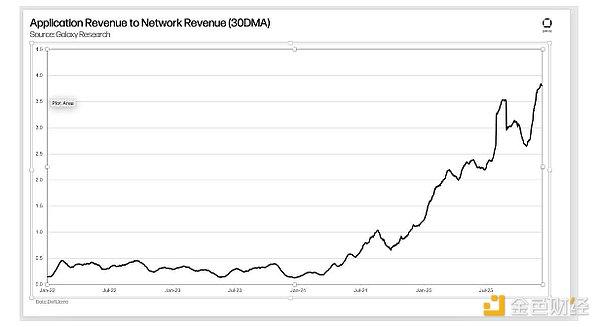As a once important growth flywheel in the crypto market, DeFi seems to have been in a dormant state for the past two years.
Although the new exchanges emerging on the Ethereum Layer2 are actively attracting liquidity, and the veteran DeFi protocols MakerDAO and Unichain are also making some adjustments, these "innovations" are more inclined towards business transformation/adjustment, with little involvement in technological and model innovation.
As a Web3 super portal that connects traffic, the perspective of the OKX Web3 wallet is more focused on how to improve the user experience and help users easily navigate the on-chain world, so this article aims to explore the DeFi form and its next step of development from the eyes of the OKX Web3 product manager.
Overall Situation of the DeFi Market and User Profile
The heat of the DeFi track in 2024 has declined, especially after the LSD and Pendle craze in the first half of the year, the market has gradually become calm, lacking new narrative drivers. However, from the beginning of the year to the present, the LSD and LRT tracks have maintained strong growth, especially the re-staking projects represented by EigenLayer, which have driven the LRT track to bring nearly $20 billion in incremental value to DeFi. At the same time, the yield market led by Pendle has also performed brilliantly, with its market capitalization growing nearly four-fold since the beginning of the year, contributing most of the increase.
In addition, the total locked-in value (TVL) of the RWA track has doubled since the beginning of the year, with private lending, government bond tokenization, and the entry of traditional financial institutions being the main driving forces. BTCFi, on the other hand, has been driven by the Taproot narrative, with developers working to activate BTC's capital and users by implementing smart contract-like functionality on the BTC mainnet, further building the DeFi ecosystem and bringing a new wave of growth.
The current total locked-in value (TVL) of the DeFi market has risen from $50 billion at the beginning of the year to a peak of $120 billion, and has now fallen back to around $80 billion. The LSD track still occupies the largest market share, followed by the lending and DEX sectors.
At the beginning of this year, the total locked-in value (TVL) of the DeFi market was $50 billion, which later peaked at $120 billion and has now fallen back to around $80 billion. The LSD track occupies the largest market share, followed by the lending and DEX sectors.
In terms of users, the current DeFi users are mainly divided into the following categories:
- Crypto native ordinary users: Their main demand is more on-chain income channels, such as earning yields through stablecoins; while advanced users pursue more complex DeFi strategies, building nested plays to achieve higher returns.
- On-chain DAO and other institutions: These users focus on treasury management and stable returns, preferring low-risk basic DeFi protocols, especially RWA that bring off-chain assets (such as US Treasuries) onto the chain as income channels.
- Traditional financial institutions: They are gradually recognizing the efficiency and composability advantages of DeFi, and are starting to on-chain traditional assets to find more distribution channels.
- Users unfamiliar with DeFi: Although these users are interested in the opportunity of higher on-chain returns, the threshold for entering DeFi is relatively high, and they need guides to lead the way.
Users suitable for participating in DeFi usually have a certain risk tolerance and strong learning ability, especially those who have a certain understanding of the on-chain ecosystem and crypto assets and are eager to explore them further are more active in DeFi.
Risks and Common Sources of Returns in DeFi
The main risks currently facing the DeFi field include the following:
- Security of the underlying smart contracts: This is the biggest risk in DeFi, as smart contract vulnerabilities can lead to protocol attacks and theft of user funds.
- Project team credibility risk: The project team may engage in rug pulls, affecting the security of user funds.
- Regulatory risk: As the scale of DeFi expands, the attention of governments and regulators around the world is increasing, and they may face stricter regulatory requirements in the future, involving issues such as KYC and AML compliance.
- Liquidity risk: DeFi protocols rely on liquidity providers, and any sudden withdrawal of liquidity (such as whale behavior) can lead to market imbalance, increased transaction costs, or triggering liquidations.
- Market risk: The functionality of many DeFi platforms depends on other mainstream cryptocurrencies, such as Ethereum. The prices of these assets may be highly volatile, which can lead to losses for users, and in severe cases, can have a significant impact on the DeFi ecosystem. In addition, DeFi hype often changes rapidly, and users need to keep up with the trends and adjust their positions in real-time, otherwise they may miss out on high-yield opportunities.
Regarding common sources of returns and common risk levels, DeFi has multiple underlying sources of returns, such as providing liquidity in DEXs to earn trading fees; earning lending interest by providing lendable assets in lending protocols; returns from staking rewards, such as Ethereum PoS rewards, and project tokens and points; for Perp perpetual contract LPs (such as GLP, JLP), returns come from the trading fees or funding rates of the counterparty; and finally, RWA (real-world asset) returns come from the returns of off-chain traditional assets such as US Treasuries or real estate. In addition, many DeFi projects also provide additional project token rewards and partner token rewards to liquidity providers.
In general, the higher the risk, the higher the returns. Relatively basic lending protocols and staking are relatively safe, but the yield is lower; while more complex operations such as providing liquidity in DEX V3 require real-time dynamic adjustment of the market making range, although the returns are higher, the risks are also correspondingly increased. Therefore, when trading, attention should be paid to selecting targets that match one's own risk tolerance.
Currently, OKX Web3 has taken certain measures on the security front, and we believe that the security of DeFi projects is the key to their large-scale adoption. Before integrating new protocols, the OKX DeFi team conducts thorough research, with the BD team responsible for evaluating the background of the project team and the technical team responsible for in-depth review of the smart contracts to ensure there are audit reports and other safeguards. As a DeFi aggregator, the OKX DeFi platform only integrates protocols that have passed security verification, and the platform does not custody user funds, only serving as a bridge for users to easily participate in DeFi. In addition, the OKX DeFi platform also provides users with an additional layer of returns, which comes from the subsidies of the project parties and are directly distributed to the users, further reducing the risk of user funds.
Current Status and Development Direction of OKX DeFi Products
Currently, RWA (real-world assets) may become a potential growth point for DeFi. As traditional assets such as real estate, bonds, and stocks are gradually introduced onto the chain, they can achieve higher liquidity and returns through DeFi protocols, and in 2024 there will be more institutions focusing on the integration of RWA and DeFi, which will bring more capital and opportunities to the DeFi ecosystem. At the same time, the interest of institutional investors in DeFi is constantly increasing, especially in areas such as stablecoin lending and yield-generating products, prompting more traditional financial institutions to explore ways to participate in the DeFi market. The involvement of institutions will drive the DeFi market to become more mature and standardized, and bring more capital inflows and more stable yield products.
In addition, CeDeFi brings innovative products by combining CeFi and DeFi, such as Ethena, a solution that combines yield-generating stablecoins; while in the BTCFi field, innovative Staking protocols based on BTC and their derived upstream LSD ecosystem, such as Babylon, have emerged.
OKX's DeFi products are mainly focused on building a one-stop DeFi aggregator, where users can participate in various DeFi protocols across the network through the OKX platform, making position management more convenient. OKX not only helps users filter out the risks of most protocols, but also does not custody user funds, and provides an additional layer of returns for users beyond the DeFi protocol websites to enhance their trading returns. In addition, OKX is also designing dedicated DeFi strategy products, aiming to help users achieve higher returns through the team's professional capabilities.
OKX's future DeFi development plan includes: building the best one-stop DeFi yield aggregator in the network, aggregating DeFi protocols on all mainstream public chains and supporting emerging hot projects to provide more early-stage yield opportunities; launching a powerful DeFi dashboard to display the positions and PnL across the network; and through the strategies of the professional team, productizing complex DeFi strategies to simplify the trading process and make it easier for more users to participate in the DeFi world.
Disclaimer
This article is for reference only. This article represents the views of the author and does not represent the position of OKX. This article is not intended to provide (i) investment advice or investment recommendations; (ii) an offer or solicitation to buy, sell or hold digital assets; (iii) financial, accounting, legal or tax advice. We do not guarantee the accuracy, completeness or usefulness of such information. Holding digital assets (including stablecoins and Non-Fungible Tokens) involves high risks and may be subject to significant fluctuations. You should carefully consider whether trading or holding digital assets is suitable for your financial situation. Please consult your legal/tax/investment professionals for your specific situation. Please be responsible for understanding and complying with the relevant applicable laws and regulations in your local area.







